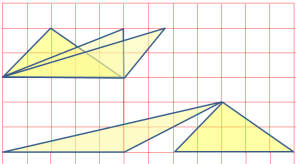The power of GeoGebra lies not only for demonstrating a concept but more so for creating a situation where students are made to think, solve problems, and reason mathematically. Here is a sample lesson on how this can be done. The lesson involves the concept of area of triangles and constructing parallel lines applied to problems involving preserving areas of polygons. The most ideal situation is for students to explore on the applets individually or in small group. If this is not possible and the students have no computers, the applets can be projected. The teacher can then call a students or two to explore the applets. The idea is to stimulate students’ thinking to think of explaining why the transformations of the shapes are possible. The students should have a triangle rulers or straight edge with them. The lesson will not be complete if the students cannot devise a procedure for transforming a triangle into other polygonal shapes with the area preserved.
The following applet may be used in the introductory activity to teach about triangles with equal areas. Click here to explore. The applet shows that all triangles with equal base and have equal heights or altitude have equal areas. That’s pretty obvious of course.
The next applet is more challenging but uses the same principle as the first.
Depending on the previous knowledge of your students you can give this second applet right away without showing the first applet on triangles. Click here or the worksheet below explore and answer the problem.
Extension problems using the same principle about area of triangles.

- Given a triangle, construct the following polygons equal in area to the given triangle using triangle rulers and pencil only: a) parallelogram; b)trapezoid; c) hexagon. (There’s nothing that should prevent you from using GeoGebra to construct them.)
- The Rosales and Ronda families are not very happy with their piece of land because of the narrow corners. Help this family to draw a new boundary line without changing the land area of each family.
I will deprive you of the fun if I will show the answers here right away, won’t I?
I will appreciate feedback on this lesson.








